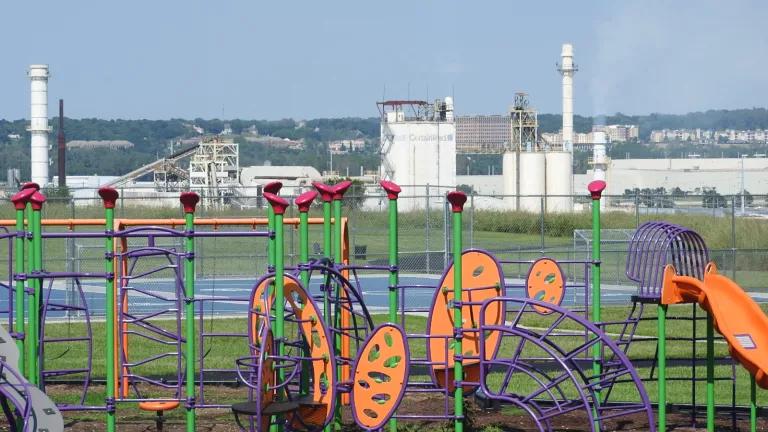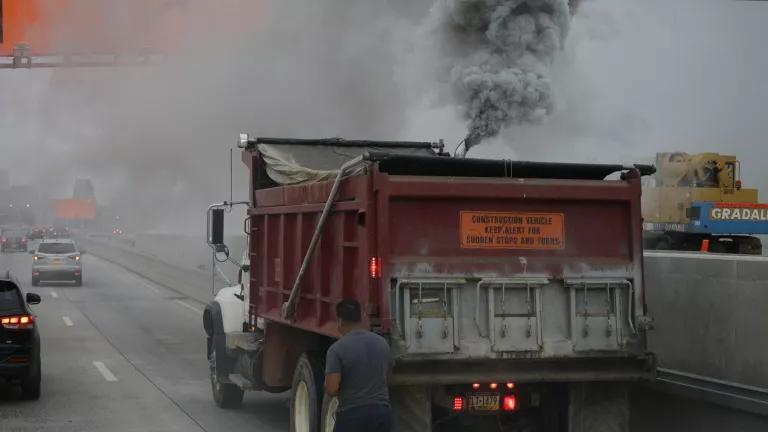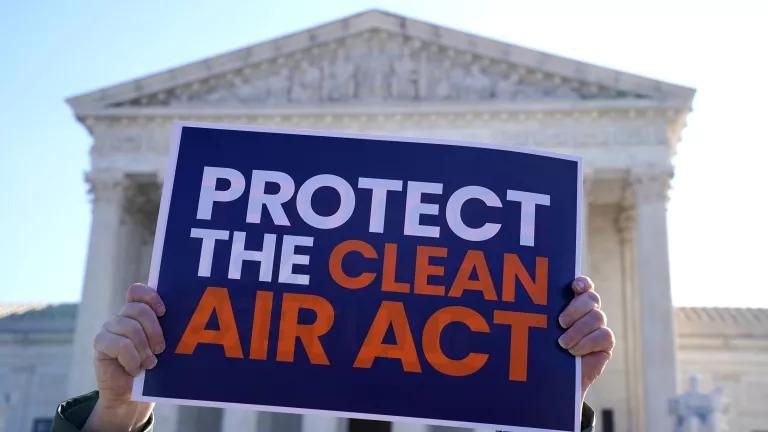Environmental Injustice: Cumulative Impacts in Kansas City
The EPA is responsible for setting environmental regulations to limit the amount of pollution industrial facilities release. This approach has been ineffective in controlling exposures because they do not take into account the cumulative impacts or toxic air contaminants.

Playground next to CertainTeed facility in Kansas City, Kansas
This blog is by Beto Lugo-Martinez and Atenas Mena, co-executive directors of CleanAirNow.
CAN is located in Kansas City, home to multiple facilities featured in our report on the life cycle chemical and environmental justice impacts of building insulation.
Kansas City, the city of fountains, has a dark history of systemic racism as portrayed in redlining where disinvestment and obstructive lending practices impeded home ownership among BIPOC communities. Today, highways slice through neighborhoods and divide the white and black populations, train yards and industries surround low-income and BIPOC communities, exposing them to higher pollution than their white counterparts. Not surprisingly in the United States, African Americans experience more deaths associated with health impacts from industrial air pollution and other fossil fuel electric generation than other racial and ethnic groups. Recently, the federal administration released their 2022 Climate and Economic Justice screening tool that will be used to determine which communities to prioritize for the Justice40 Initiative funding. Even though there is enough data that determines communities of color are disproportionately harmed by environmental injustice, the government did not consider race as an indicator.
The EPA is responsible for setting environmental regulations to limit the amount of pollution industrial facilities release. This approach has been ineffective in controlling exposures, because they do not take into account the cumulative impacts or toxic air contaminants. Cumulative impacts acknowledges the complex human experiences by taking the threats and vulnerabilities of an individual or community to determine the inherent risk to health and livelihood. For example, instead of focusing on one smoke stack or one semi-truck’s exhaust, consider the whole picture of the combined chemicals and toxins coming from all polluting sources released onto a community and how they are impacting the health of that community. In Kansas City, industries like Certainteed and Owens Corning have time and time again exceeded the regulatory limits for chromium, among other toxic chemicals. Such malpractices are concerning given how close in proximity the facilities are to each other and communities. Chromium is a known carcinogen and a dangerous toxin to vital organs in the body including the lungs, brain, and liver.9 Releasing excessive amounts of chromium and other hazardous chemicals increases the risk of cancer and compounds with the health inequities fenceline communities already face, many of which are communities of color.
It seems we have arrived at the point of blatant preference of profit over people, where industries are allowed to poison the lungs and bodies of the community with no ramifications or consequences. Another form of clear lack of regulation and safety risk is industries in Kansas City not implementing transparent and clear risk management plans to notify their staff and community for when a chemical spill, or gas leak or even an explosion occurs. Such blind sided planning needs to be addressed immediately, because we know the question isn’t “if '' a disaster will occur, but “when” it occurs and how many lives will this oversight cost us? Such industries are accelerating climate change, perpetuating the risk for severe weather events and increasing the risk for negative health impacts, which are particularly concerning for populations that are low-income households, communities of color, immigrant groups, Indigenous peoples, children and pregnant women, the elderly, and persons with disabilities or chronic medical conditions. As we consider the planning for a green infrastructure, health, safety, community-led decision making, and a just transition for workers must be at the forefront for a successful and equitable movement.
Unfortunately, the same community members working in fossil fuel industries are the same living fenceline to them, meaning they are being burdened with pollution at work and at home. Overburdened communities often spend a larger portion of their income on energy bills, which is commonly referred to as energy burden. The inefficient, run-down housing conditions common in many environmental justice communities cause higher energy use which—when coupled with lower incomes—contributes to higher energy burden. High energy burden is an economic, social, and public health concern: those with high energy burdens report having to choose between necessities such as healthcare, food, and home heating or cooling. The high energy burdens and energy related environmental and public health burdens characteristic of environmental injustice mean that they face increased risk from climate-related impacts; they typically do not have the economic means to move out of harm’s way during an extreme weather event or relocate to areas with less climate risk. In addition, climate change is expected to lead to more intense heat waves, leaving lower income communities more vulnerable to heat-stress related health impacts. Populations with lower socioeconomic status are more vulnerable to mortality during extreme heat events.
CleanAirNow (CAN), an environmental justice organization in Kansas City, works to bring systemic change in industry and government policies and practices to protect health and to advance justice. Ultimately, we organize, advocate and support policies that will truly benefit communities of color who are still fighting to have a seat at the table. Collectively with community guidance, CleanAirNow put together Cumulative Impact Recommendations for governing bodies to implement in their climate action planning:
- Thoughtfully and strategically include the community experience and perception on health outcomes and environmental hazards from polluting facilities.
- Involve an environmental justice lens with health equity as a measurable outcome for strategies and plans being put in place
- Conduct a thorough cumulative impact analysis by including context (consequences of proposal or activity and identifying overburdened communities), stressors (chemical, biological, social, and physical), and vulnerabilities (intrinsic and extrinsic) and communicate to the community and plan how strategies are guided by results.
- Set clear and measurable outcomes that reduce major health concerns such as asthma, lung disease, cancer or even the gap in life expectancy between ZIP codes
- Integrate health equity-based programs and projects that will improve access to care, reduce social burdens, and eliminate environmental hazards
- Develop and implement environmental justice policies to prioritize health outcomes for overburdened communities
- Dismantle racist systemic practices and policies that continue to disproportionately impact the livelihood of overburdened communities
- Utilize mapping tools that can visually demonstrate the social indicators and stressors the community is facing and identify any potential environmental factors exacerbating negative health outcomes.
- Ensure that new permits and projects are centered around environmental justice and equity to prevent future harm to the most disadvantaged communities.
- Ensure the public has easy access to all information and data used for decision-making includes a cumulative impact analysis.
- Strict enforcement of facilities operating on violations or expired permits.
We support implementation of community led solutions that center on equity and environmental justice through the inclusion of frontline communities in local, state, and federal decision making.

Beto is an environmental justice organizer and shares a leadership co-executive director role at CleanAirNow alongside Atenas Mena. Beto serves to raise community voices in the fight against environmental racism and to overcome systemic exclusion of frontline communities from the decision making process. His lived experience, growing up fenceline to a petrochemical facility continues to drive his work at the intersection of environmental justice, climate and public health. He is a founding member of the California Environmental Justice Coalition, and member of national CJ & EJ networks including the EJ Leadership Forum and the National Leadership Advisory Board Member of the Moving Forward Network. Beto’s contributions to the movement include organizing, policy that prioritizes environmental justice and community led research amongst many other community engaged initiatives that directly influenced state policy. Beto has co-authored multiple academic publications on community based participatory research, air pollution, data accessibility, community engagement and guidebook on how to develop an air monitoring network. In August 2021 Beto was invited to serve on the Federal Clean Air Act Advisory Committee, to represent a grassroots frontline perspective.

Atenas Mena is the Environmental Health Director and shares co-leadership role at CleanAirNow. Atenas Isabel Mena, born and raised in Kansas City, is a proud first generation Mexican American. Ms. Mena received her Bachelor’s degree in Nursing from Avila University in 2014 and went on to receive her Master’s in Nursing Leadership from Missouri Western State University in 2019. In addition to working as a nurse, Ms. Mena received extensive environmental health training in the field, working with the Children’s Mercy environmental health team, as both an educator as well as a team coordinator. Ms. Mena worked continuously throughout the last few years with CleanAirNow through boots on the ground projects, served as a Board of Directors, and has just recently transitioned into the current leadership role as environmental health director. Atenas centers her work around reducing health inequities, educating communities on environmental health impacts, and empowering community members to have a voice and fight for equity and environmental justice.



